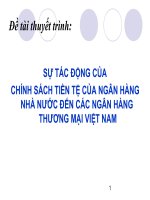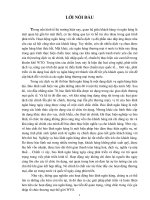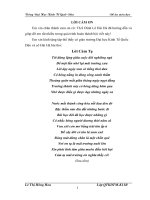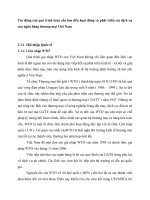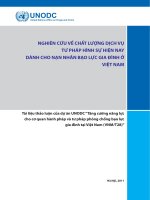Nghiên cứu tác động của dịch vụ ngân hàng quốc tế đến hiệu quả hoạt động của các ngân hàng thương mại việt nam atract
Bạn đang xem bản rút gọn của tài liệu. Xem và tải ngay bản đầy đủ của tài liệu tại đây (369.46 KB, 27 trang )
MINISTRY OF EDUCATION AND TRAINING
UNIVERSITY OF ECONOMICS OF HO CHI MINH CITY
-----------------------------
HUYNH THI HUONG THAO
RESEARCHING THE IMPACTS OF
INTERNATIONAL BANKING SERVICES
TO OPERATIONAL EFFICIENCY OF
VIETNAM COMMERCIAL BANKS
Major: Finance and Banking
Code: 62340201
SUMMARY OF ECONOMIC DOCTORAL THESIS
Ho Chi Minh City - 2016
The work was completed at:
University of Economics of Ho Chi Minh City
The scientific instructors:
Assoc. Prof. Dr. Tran Huy Hoang
Reviewer:
1.
2.
3.
The thesis will be protected in front of thesis scoring
council at
the University of Economics of Ho Chi Minh City
at ... hour ......day ......month ...... 2016
The thesis can be studied at:
- Synthesis Scientific Library in Ho Chi Minh City
- Library of University of Economics of Ho Chi Minh City
PUBLISHED SCIENTIFIC WORKS
1. Huynh Thi Huong Thao, 2015. Development orientation of
international banking services of Vietnam commercial banks.
Financial & Monetary Review, No. 431, p. 20-23.
2. Huynh Thi Huong Thao, 2016. Measurement of operational
efficiency of Vietnam commercial banks. Banking Science &
Training Review, No. 168, p. 43-48.
3. Huynh Thi Huong Thao, 2016. Researching the impacts of
international banking services to the operational efficiency of
Vietnam commercial banks. Banking technology Review No.
123, p. 44-53.
INTRODUCTION
1
INTRODUCTION
1. Reason for study of the thesis
Competitive pressure has helped Vietnam banking system
has made positive changes in scale of operation, quality of services,
financial capacity. In efforts to maintain market shares, stable and
profitable growth, Vietnam commercial banks (VCB) has given
many new products and services gradually to diversify their
profitable operations. Despite international banking services (IBS)
was the development focus of VCB but must have long-term
development strategies to adapt to the fierce competition. Therefore,
the study of the impacts of IBSs to operational efficiency (OE) of
VCB in recent years as well as providing solutions to improve OE
and develop IBS is needed.
2. The aim of the thesis’ research
The impact study of IBS to OE of banks has important
implications, especially for administrators so that banks will have the
analysis and evaluation required in the strategic decisions for
themselves. So the research has the following objectives:
- Study IBS indicators of VCB nowadays.
- Study of the impact of the IBS to OE of VCB.
3. Object and scope of the research
The thesis chosen object of study is the impacts of IBS to OE
of VCB. Research’s data taken from annual reports or financial
statements were audited from 38 banks include state commercial
banks and joint stock commercial banks in period 2008-2014.
4. Research methodology
The study used qualitative and quantitative methods. The
qualitative method were conducted through interviewing directly
2
with experts, bank managers. Quantitative methods to study the
thesis includes: method of non-parametric analysis through DEA
model; regression models with pooled ordinary least squares - Pooled
OLS, fixed effect model – FEM, random effect model - REM,
feasible generalized least squares - FGLS.
5. Structure of the subject
In addition to the introduction, conclusion, appendices,
references, structure of the thesis consists of 5 chapters.
6. Practical significance of the thesis
Scientific contributions:
+ The thesis has codified the general theoretical issues of
IBS and OE, the importance of IBS, the relationship between IBS
and OE of banks in the context of international integration and fierce
competition in the banking and financial banking sector.
+ The thesis has identified the IBS indicators impact to OE
of VCB, thereby determining the model of the impacts of IBS to OE,
this is a new point and no duplication of the thesis.
+ This is the first study to apply quantitative methods
through a systematic way approach with DEA, Pooled OLS
regression method, FEM, REM, FGLS and necessary tests such as: F
test, Hausman test, Pagan Lagrangian Breusch test, Modified Wald
test, Wooldridge test to study the impacts of IBS to OE of VCB that
no previous research done.
Practical contributions:
+ The thesis has quantified OE of VCB period 2008-2014,
this research’s results is a scientific reference help administrators
assess the plans’ completion level and growth of OE of banks. The
thesis has analyzed the IBS’s positive factors, negative factors that
3
influence OE of banks, which propose solutions to promote positive
factors, control negative factors, improve OE constantly and develop
highly diversity of products and services of banks especially IBS.
+ In addition, this research is the scientific basis for the
Government and the State bank to identify factors affecting OE of
VCB which can make policies timely and reasonable in order to
establish a solid banking system, ensure a healthy and effective
banking business.
4
CHAPTER
1:
OVERVIEW
OF
THEORY
AND
EXPERIMENTAL STUDY ON INTERNATIONAL BANKING
SERVICES
AND
OPERATIONAL
EFFICIENCY
OF
COMMERCIAL BANKS
1.1. International banking services of banks
1.1.1. The concept of international banking services
According to the Foreign Exchange Ordinance in 2005 and
Foreign Exchange Ordinance amended in 2013, on the territory of
Vietnam, foreign exchange transactions in limited use except for
cases permitted including resident and non resident. Decree No.
24/2012/ND-CP
dated
03/04/2012
of
the
Government
on
management of gold trading activities and Circular No. 16/2012/TTNHNN dated 25/05/2012 guiding some articles of Decree
24/2012/ND-CP was issued to move policy "mobilization and
lending in gold" to relations "buy, sell gold", so the scope of the
thesis of foreign exchange transactions of banks are in foreign
currency. On the basis of inheriting the concept of IBS and legal
documents in Vietnam, concepts of IBS used in this thesis is the
banking services related to foreign currency provided by banks.
1.1.2. The role of international banking services
In conditions of an open economy, the liberalization of trade
and finance, the demand of IBS will develop increasingly towards
combining harmoniously between the interests of customers with the
benefit of banks and bring benefits to the economy.
1.1.3. The international banking services of banks
IBS includes the following services: foreign exchange
services, international payment services, foreign currency lending
services, international card services, correspondent banking services.
5
1.2. Operational efficiency of commercial banks
1.2.1. The concept of operational efficiency of commercial banks
Efficiency in economy is consided the level of success that
the production units or banks achieved in the distribution of inputs
to optimize outputs, reflecting the level of use of resources (human,
financial and material resources, capital) to achieve defined goals
(Nguyen Khac Minh, 2004).
1.2.2. The methods of evaluating the operational efficiency of
commercial banks
The present studies in the world analyzes about OE usually
use two main methods are: financial indicators and marginal
efficiency.
1.2.2.1. The method of using financial indicators
To evaluate OE by financial indicators of commercial
banks, the two indicators most often used as ROA and ROE. Besides
two profitable indicators of business, OE of banks is also reflected
by indicators on the marginal income ratio.
1.2.2.2. Marginal efficiency analysis method
The research using DEA method, DEA’s results includes:
technical efficiency (TE) or whole TE, pure technical efficiency
(PTE) and scale efficiency (SE).
1.3. The relationship between international banking services and
OE of banks
IBS can not stand individually that can only grow well in
horizontal and vertical linkages with other services of banks,
together with support and the rise of mutual control. In terms of the
nature and history of the development, IBS is always a useful part,
tied to domestic banking services and created the entire business
6
operations of a bank. IBS is an integral part of the banks' business
activities and the development of IBS will impact on OE of banks
certainly and effectively. Therefore, the study of the impact of IBS
to OE is truly meaningful and essential.
1.4. The studies of IBS and OE in Vietnam and abroad, gaps in
research in Vietnam
1.4.1. The studies published in Vietnam
With the in-depth studies on IBS in Vietnam, the authors
only just at the described statistical or inductive, deductive method
without qualitative research and quantitative research to study
specially about OE and IBS.
Overall, through the studies of OE of banks could judge by
the financial indicators such as ROA, ROE or using non-parametric
methods as DEA. OLS regression model or Topit often used for
studies analyzes the factors affecting banks' OE. There have been a
number of separate studies on the impact of a banking service or
specific indicators of banks, such as bad debt, non-credit services,
income diversified levels ... for banks’ OE but which IBS’ research
does not have a domestic research use quantitative methods to
examine the impact of IBS to OE.
1.4.2. The quantitative studies published in other countries
Through surveys of researchs in the world, the author
found that the most researchs used DEA methods to estimate OE
when applying analytical methods of marginal efficiency, Pooled
OLS regression method, FEM, REM also used to analyze the
factors affecting OE in the studies. This demonstrates the
superiority of the DEA and regression methods in assessing the
overall picture of the banks’ OE in each country.
7
1.4.3. Some problems existed in studies
The study is based on previous studies and has some new
features based on the following grounds:
(1) Economic integration to create conditions for the
banking system and the development of banking services as
Claessens (2009), Sufian (2011).
(2) Diversification of banking services both domestic
banking services and IBS will help banks maximize profits
(Chiorazzo et al, 2008; Gurbuz et al, 2013; Vo Xuan Vinh et al,
2015 and Nguyen Thi Canh et al, 2015).
(3) The fact that there are many studies on the impact of
banking services to OE but still do not have any projects in
Vietnam and around the world gives a quantitative model of the
impact of IBS to OE of commercial banks.
Thus, this thesis will be the difference compared with the
previous studies on the content of research and the research model
when using Pooled OLS regression model, FEM, REM, FGLS to
assess the impacts of IBS to OE period 2008-2014. Thereby, this is
the perfect basis for a rational policy framework of the operating
management of banks in Vietnam during the integration period.
8
CHAPTER 2: REALITY OF OPERATIONAL EFFICIENCY
AND
INTERNATIONAL
BANKING
SERVICES
0F
VIETNAM COMMERCIAL BANKS
2.1. Business operation of Vietnam commercial banks
2.1.1. Business network of Vietnam commercial banks
By the end of 2014, commercial banking system in
Vietnam includes: 05 state-owned banks including Agribank,
BIDV, Vietcombank, Vietinbank, MHB (BIDV, Vietcombank,
Vietinbank, BIDV has been equitized but still have over 51% of
state capital should put in kind of state-owned commercial banks);
33 joint stock commercial banks; 54 foreign banks and foreign
bank branches; 04 joint venture banks.
2.1.2. Financial capability
As of 31/12/2014, the size of the chartered capital of the
VCB is modest, so the financial capacity of the domestic banks is
still a matter for concern.
2.1.3. Technological capacity
Many banks have adopted the world's leading technology,
but also many banks still apply the technology level is low, which
makes it difficult for banks to coordinate services that requires a
high link, such as connectivity between bank card use, foreign
currency trading, factoring agent .... Thus, VCB have a large
investment in the banking technology sector, however, are not equal
level (Nguyen Thi Kim Thanh, 2010).
2.1.4. Human resources
Currently, the staff of most VCB have been trained
systematicly, university graduated rate is over 70%. This is a good
sign and is one of the favorable conditions for VCB improve
9
competitiveness. (To Ngoc Hung, 2010).
2.1.5. Some of the main business activities of VCB
2.1.5.1. Deposit mobilizing services
Total deposits of whole banking system increased steadily,
by the end of 2014, total deposits reached 4.507 trillion. The
increasing or decreasing deposits of credit institutions (CI) is due to
meet the needs of the social capital, CI should be adjusted to suit the
demand for loans or governed by the policies, regulations to
mobilize funds from the central bank in each period.
2.1.5.2. Credit services
Total outstanding loans of whole banking system has
increased steadily over the years. The highest non-performing loan
ratio in the period 2008-2014 is 4,08% in 2012, then dropped to
3,61% in 2013 and 3,25% in 2014.
2.1.5.3. Payment services
With the successful implementation of investment projects to
modernize technology, particularly technology serves for billing,
payment service quality of banks improved significantly. Sales of
domestic payments and international payments reached a high
growth rate.
2.2. Operational efficiency of VCB
2.2.1. The scale of assets, equity and earnings of VCB
The assets size of commercial banks has steadily increased
over the years shows that VCB were improving financial strength
constantly to increase their competitiveness. In Vietnam today, the
number of banks is quite large, but the size of each bank's total assets
is not high when compared with banks in the developed countries in
the region.
10
In 2008, non-interest income reached average value 542
billion. In 2009, the central bank's efforts to deal with the impact of
the global economic crisis, Vietnam's economy has been gradually
recovering, the stock market has gradually developed a more upbeat,
average non-interest earnings increased to reach 667 billion, but the
average interest income decreased to 4.785 billion, this was the year
that the average interest income is lowest in period 2008-2014.
2.2.2. Profitability of VCB
The most important index reflecting business efficiency and
profitability ratios of banking sector is ROA, ROE, NIM. ROA, ROE
of banks decreased over the years; especially ROE, ROA of 2013 is
5,46% and 0,54% respectively.
2.3. Reality of international banking services of VCB
2.3.1. The legal basis of international banking services in
Vietnam
The specific laws governing each IBS adhere mainly by laws
of State bank of Vietnam (SBV) issued and the international practice
by the International Chamber of Commerce issued. International
Chamber of Commerce is a highly reputable non-governmental
organization in the field of international trade and finance has issued
a number of rules governing trading in IBS such as UCP, URC,
URR, URDG, Incoterms.
2.3.2. Some mainly international banking services of VCB
2.3.2.1. Currency trading services
Since appearing, the derivative currency services in Vietnam
has been growing very modestly with the pilot program of the central
bank. A number of complex derivative products have appeared but
very limited and operate mostly by foreign banks in Vietnam.
11
2.3.2.2. International payment services
VCB are growing network of correspondent banks constantly
serving international payments in order to meet the needs of
customers. However, compared to the system of some correspondent
banks by foreign banks in Vietnam may find their superior
advantages. With this reality, many VCB searched the area of
business in other country in line with standards and its resources.
2.3.2.3. Factoring services
Realizing the necessity of factoring business for Vietnam
enterprises, dated 09.06.2004, SBV has issued regulations on
factoring activities for CI prescribed 1096/2004/QĐ-NHNN. The
introduction of this legislation was created CI’s motivation initially
and development of factoring services. And it was early 2005,
factoring services deployed in Vietnam officially.
2.3.2.4. Correspondent banking services
For overseas markets, the Vietnam banking brands are only
known in some markets such as Laos, Cambodia, Myanmar ....
Therefore, development of IBS overseas is now difficult because
VCB have not really a strong brand, which is not known to the world
market.
12
CHAPTER 3: RESEARCH METHOD
3.1. Qualitative research
3.1.1. The purpose and methodology
In this study, 10 experts (in particular in Annex 1) have
discussed with the author bilaterally to review and make new
discoveries about the indicators reflecting IBS in Vietnam. The
discussion was conducted to clarify the following issues:
- The definition of IBS of commercial banks in Vietnam.
- The importance of IBS in Vietnam.
- The impact of IBS to OE of commercial banks in Vietnam.
- Identify and assess IBS in Vietnam currently.
- Defining IBS’ indicators for evaluation of commercial
banks in Vietnam.
3.1.2. Qualitative research results
Based on the concept of IBS used unitedly in the study and
based on indicators reflected in the accounting balance sheet and
income statement of VCB, experts offer the two most common
evaluation unified indicators for IBS as follows:
Indicator 1: Foreign currency loans to the total foreign
currency assets ratio.
Indicator 2: Foreign currency liabilities to total liabilities
and capital ratio.
3.2. Quantitative research
3.2.1. Research data
To implement the research, the author has collected data on
financial statements or annual reports of 38 VCB period 2008-2014,
the Vietnam macroeconomic data such as economic growth,
inflation rates are collected from the General Statistics Office.
13
3.2.2. Description of the studied variables
3.2.2.1. For operational effeciency research of VCB
Input variables: includes interest expenses (X1), wage costs
(X2) and other expenses (X3).
Output variables: consists of interest income (Y1) and other
income (Y2).
3.2.2.2. For studying the impact of international banking
services to operational efficiency of VCB
- Dependent variables: technical efficiency (TE), pure
technical efficiency (PTE), scale efficiency (SE).
- Independent variables includes: the total foreign currency
loans to foreign currency assets ratio (FLFA) and foreign currency
liabilities to total liabilities and capital ratio (or foreign currency
liabilities on total assets (FLTA)).
- Control variables includes: equity to total assets ratio
(ETA), the size of bank assets (SIZE), loans to total assets ratio
(LTA), deposits to loans ratio (DTL), economic growth (GDP), rate
of inflation (IFL).
3.2.3. Research model and hypotheses
Model 1: TE = ε + β1*FLFA + β2*FLTA + β3*ETA +
β4*SIZE + β5*LTA + β6*DTL + β7*GDP + β8*INL
Model 2: PTE = ε + β1*FLFA + β2*FLTA + β3*ETA +
β4*SIZE + β5*LTA + β6*DTL + β7*GDP + β8*INL
Model 3: SE = ε + β1*FLFA + β2*FLTA + β3*ETA +
β4*SIZE + β5*LTA + β6*DTL + β7*GDP + β8*INL
14
Table 3.4: The research hypothesis
Hypothesis
Hypothesis 1
Content
There are same or opposite correlations between
FLFA and TE of banks
Hypothesis 2
There are same or opposite correlations between
FLTA and TE of banks
Hypothesis 3
There are same or opposite correlations between
FLFA and PTE of banks
Hypothesis 4
There are same or opposite correlations between
FLTA and PTE of banks
Hypothesis 5
There are same or opposite correlations between
FLFA and SE of banks
Hypothesis 6
There are same or opposite correlations between
FLTA and SE of banks
Source: Compiled by the author
3.2.4. Research methods and testing
Research on DEA method to analyze OE which will
determine TE, PTE, SE of VCB period 2008-2014 by DEAP 2.1
software. Next, research used panel data is regressed with 4 ways:
Pooled OLS, FEM, REM, FGLS by Stata 11.1.
15
CHAPTER
4:
RESEARCHING
INTERNATIONAL
OPERATIONAL
BANKING
THE
IMPACTS
SERVICES
EFFICIENCY
OF
OF
TO
VIETNAM
COMMERCIAL BANKS
4.1. Researching the operational efficiency of VCB
4.1.1. Describing statistics the sample data variables
Number of banks studyding are not equal over the years,
number of banks in 2008 is 35, in 2009 is 36 banks because
Baovietbank were established in this year and 2010, 36 banks were
also studied. In 2011, there are 35 banks under study because could
not be collected data of Tienphongbank and number of banks in
2012 is the same as 2011. In 2013, there were 34 banks in studying
and in 2014, the research could study 31 banks.
4.1.2. Results of the OE estimation of VCB by DEA
4.1.2.1. Results of TE estimation by DEACRS
The average TE of the samples over the years 2008, 2009,
2010, 2011, 2012, 2013, 2014 is 0,862; 0,917; 0,893; 0,946; 0,943;
0,931; 0,92 respectively, this shows that TE of Vietnam commercial
banks have reached only 86,2% in 2008; 91,7% in 2009; 89,3% in
2010; 94,6% in 2011; 94,3% in 2012; 93,1% in 2013 and 92% in
2014.
4.1.2.2. Results of PTE estimation by DEA VRS
The average PTE over the years 2008, 2009, 2010, 2011,
2012, 2013, 2014 is 0,918; 0,959; 0,938; 0,966; 0,971; 0,951; 0,94
respectively. This suggests that PTE of VCB is only 91,8% in 2008;
95,9% in 2009; 93,8% in 2010; 96,6% in 2011; 97,1% in 2012;
95,1% in 2013 and 94% in 2014.
16
4.1.2.3. Scale efficiency of VCB the period 2008-2014
The average SE over the years 2008, 2009, 2010, 2011,
2012, 2013, 2014 is 0,939; 0,956; 0,952; 0,979; 0,972; 0,979; 0,98
respectively. This shows that SE of VCB is 93,9% in 2008; 95,6%
in 2009; 95,2% in 2010; 97,9% in 2011; 97,2% in 2012; 97,9% in
2013 and 98% in 2014.
4.1.2.4. The estimation results of Malmquist index
The average total factor productivity (TFP) index change in
period 2008-2014 was 0,971 (less than 1) means a decline of 2,9%
in the TFP in 7 years. The cause of this decline is due to changes in
technology factor fell by 4,2% despite improvements in the
technical efficiency change (up 1,3%) but lower than the decline of
technological factors during this period.
4.2. Experimental study the impacts of international banking
services to operational efficiency of VCB
4.2.1. Descriptive statistics of the variables
Data are presented as descriptive statistics, each variable
described as: variable name, number of observations, the minimum
value, maximum value, average value, standard deviation from
which conduct a general analysis of the variables included in
models.
4.2.2. Correlated coefficient results between variables
Correlated analysis was used to examine the relationship
between the independent variables and the dependent variables.
Correlated analysis results can assess the model's forecasts initially.
Also, in the case of the independent variables have high correlation,
this is a sign of multicollinearity, so this is a basis for the
multicollinearity accreditation for the author to adjust models.
17
4.2.3. Multicollinearity inspection results
The correlation coefficient between the independent
variables are less than 0,8 which shows that the possibility of
multicollinearity phenomenon is low as regression analysis.
4.2.4. Research results for the dependent variable TE
4.2.4.1. Selection and testing the regression models for
dependent variable TE
For the sample whole banks: Through the F-test (P-value
= 0,0000) and Hausman test (P-value = 0,0782), the model was
selected as REM. However, when testing the variance change (Pvalue = 0,0000) and the autocorrelation (P-value = 0,0016), the
model have variance change phenomenon and autocorrelation. To
correct the variance change and autocorrelation, regression model is
selected FGLS for studying the whole sample banks.
For the sample banks group 1: Through the F-test (Pvalue = 0,0478) and Hausman test (P-value = 0,8323), the model
was selected as REM. However, when testing the variance change
(P-value = 0,2140) and the autocorrelation (P-value = 0,0184), the
model
has
autocorrelation
phenomenon.
To
overcome
the
autocorrelation, regression model FGLS selected for banks group 1.
For sample banks group 2: Through the F-test (P-value =
0,0000) and Hausman test (P-value = 0,6646), the selected model is
REM. However, when testing the variance change (P-value =
0,0000) and the autocorrelation (P-value = 0,0041), the model have
variance change phenomenon and autocorrelation. To correct the
variance change and autocorrelation, regression model FGLS is
selected for banks group 2.
18
4.2.4.2. Discuss the results of research and hypothesis testing for
the dependent variable TE
FLFA variable have opposite impact to TE with statistical
significance at 5% for banks group 1 and no statistical significance
for the whole sample banks and banks group 2 show that the
increase in foreign currency lending will not bring greater efficiency
to the banks group 1, which banks have foreign currency lending to
total loans significantly. Based on the findings above, we reject the
hypothesis 1 for the whole sample banks and banks group 2 because
the regression coefficient is not statistically significant, accept the
hypothesis 1 for the sample is banks group 1.
FLTA have the same impact to TE with the whole sample
banks and banks group 2 at statistical significance 5% and 10%
respectively. FLTA have positive correlation suggests if banks use
foreign currency funds mobilized well will increase OE, create more
investment opportunities for banks. Based on the results above, we
reject hypothesis 2 for banks group 1 due to the regression
coefficient is not significant statistically, accept hypothesis 2 for the
whole banks and banks group 2.
4.2.5. Research results for the dependent variable PTE
4.2.5.1. Selection and regression models testing for dependent
variable PTE
For the whole banks: Through the F-test (P-value =
0,0000) and Hausman test (P-value = 0,2888), the model was
selected as REM. However, when testing the variance change (Pvalue = 0,0000) and the autocorrelation (P-value = 0,0023), the
model have variance change phenomenon and autocorrelation. To
correct the variance change and autocorrelation, regression model is
19
selected FGLS for the whole sample banks.
For the sample banks group 1: Through the F-test (P-value
= 0,0010) and Hausman test (P-value = 0,0683), the model is
selected as REM. However, when testing the variance change (Pvalue = 0,0173) and the autocorrelation (P-value = 0,0555), the
model have variance change phenomenon. To correct the variance
change, FGLS regression model is selected for banks group 1.
For the sample banks group 2: Through the F-test (P-value
= 0,0000) and Hausman test (P-value = 0,4242), the selected model
is REM. However, when testing the variance change (P-value =
0,0000) and the autocorrelation (P-value = 0,0038), the model have
variance change phenomenon and autocorrelation. To correct the
variance change and autocorrelation, regression model FGLS is
selected for banks group 2.
4.2.5.2. Discuss the results of research and hypothesis testing for
the dependent variable PTE
FLFA variable have opposite impact to PTE but no
statistical significance. Therefore, hypothesis 3 is rejected.
However, this result shows foreign currency lending of banks does
not bring well to OE of banks demonstrate that management of the
risks of foreign currency lending activity is not good.
FLTA have same impact to PTE of the whole sample banks
and banks group 1 were at 5% significance level. FLTA have
positive correlation suggests if banks use foreign currency funds
mobilized well will increase OE, create more investment
opportunities for banks. With this result, we accept hypothesis 4 for
the whole sample banks and banks group 1, reject hypothesis 4 for
banks group 2. Banks group 1’s regression coefficient is higher than
20
the whole sample banks demonstrates with management ability, the
banks group 1 raises deposits in foreign currencies as much as it
will increase OE.
4.2.6. Research results for the dependent variable SE
4.2.6.1. Selection and regression models testing for dependent
variable SE
For the whole sample banks: Through the F-test (P-value =
0,0000) and Hausman test (P-value = 0,0002), the model is selected
as FEM. However, when testing the variance change (P-value =
0,0000) and the autocorrelation (P-value = 0,0377), the model have
variance change phenomenon and autocorrelation. To correct the
variance change and autocorrelation, regression model is selected
FGLS for the whole sample banks.
For banks group 1: Through the F-test (P-value = 0,0010)
and Hausman test (P-value = 0,2865), the model is selected as REM.
However, when testing the variance change (P-value = 0,3333) and
the autocorrelation (P-value = 0,0709), the model have no changing
phenomenon variance and autocorrelation. So REM regression model
is selected for banks group 1.
For banks group 2: Through the F-test (P-value = 0,0020)
and Hausman test (P-value = 0,8692), the selected model is REM.
However, when testing the variance change (P-value = 0,0046) and
the autocorrelation (P-value = 0,1910), the model have variance
change phenomenon. To correct the variance change, FGLS
regression model is selected for banks group 2.
21
4.2.6.2. Discuss the results of research and hypothesis testing for
the dependent variable SE
FLFA have impact negatively on the whole sample banks and
the banks group 1 demonstrates that the increased activity of foreign
currency loans do not increase SE. In contrast, for the banks group 2
when increasing foreign currency lending will increase SE. However,
this result is not significant statistically, so hypothesis 5 should be
rejected.
FLTA have impact negatively on the whole sample banks and
the banks group 1 demonstrates that the increased activity of foreign
currency deposit mobilization does not increase SE. In contrast, for
the banks group 2, when raising foreign currency deposit mobilization
will increase SE. However, this result is not significant statistically so
hypothesis 6 should be rejected.
22
CHAPTER
5:
DEVELOPMENT
SOLUTIONS
OF
INTERNATIONAL BANKING SERVICES TO IMPROVE THE
OPERATIONAL
EFFICIENCY
OF
VIETNAM
COMMERCIAL BANKS
5.1. Development orientations for developing IBS to improve OE
of VCB in conditions of integration
- The strong need for innovation of VCB in organizational
models, expanding transnational activities and can gradually
established a number of financial conglomerates; expanding dealer
relations, business cooperation, product development, application and
transfer of technology with foreign financial institutions.
- SBV implement monetary policy effectively, actively:
operating exchange rates and interest rates in sync with the
development of the money market consistently with international
practice and the practical conditions of Vietnam, bonding closely
exchange rate and interest rate management.
5.2. Solutions for developing IBS to improve OE of VCB
5.2.1. Expanding foreign currency deposits of banks
According to research results, FLTA variable have
correlated positively with TE and PTE, this result demonstrates that
banks should increase in foreign currency deposits to enhance OE.
To improve the ability to mobilize in foreign currency, in addition to
a reasonable interest rate policy, VCB should consider operation
scale through branches are allocated according to appropriate
geographic area nationally as well as countries in the region.
5.2.2. Foreign currency credit restriction
According to research results, FLFA have opposite
relationship with TE for banks group 1 which have large foreign
